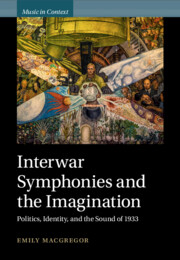Book contents
- Interwar Symphonies and the Imagination
- Music in Context
- Interwar Symphonies and the Imagination
- Copyright page
- Dedication
- Contents
- Figures
- Examples
- Preface
- Acknowledgements
- Abbreviations
- 1 Between Europe and America: Kurt Weill’s Symphony in a Suitcase
- 2 Listening for the Intimsphäre in Hans Pfitzner’s Symphony in C♯ Minor
- 3 Liberalism, Race, and the American West in Roy Harris’s Symphony 1933
- 4 Aaron Copland’s and Carlos Chávez’s Pan-American Bounding Line
- 5 Arthur Honegger’s ‘Modernised Eroica’
- 6 The Right Kind of Symphonist: Florence Price and Kurt Weill
- Select Bibliography
- Index
1 - Between Europe and America: Kurt Weill’s Symphony in a Suitcase
Published online by Cambridge University Press: 28 January 2023
- Interwar Symphonies and the Imagination
- Music in Context
- Interwar Symphonies and the Imagination
- Copyright page
- Dedication
- Contents
- Figures
- Examples
- Preface
- Acknowledgements
- Abbreviations
- 1 Between Europe and America: Kurt Weill’s Symphony in a Suitcase
- 2 Listening for the Intimsphäre in Hans Pfitzner’s Symphony in C♯ Minor
- 3 Liberalism, Race, and the American West in Roy Harris’s Symphony 1933
- 4 Aaron Copland’s and Carlos Chávez’s Pan-American Bounding Line
- 5 Arthur Honegger’s ‘Modernised Eroica’
- 6 The Right Kind of Symphonist: Florence Price and Kurt Weill
- Select Bibliography
- Index
Summary
Part introduction to the frame around 1933, part initial case study, the first chapter introduces Kurt Weill’s Symphony No. 2, the symphony-in-progress he carried in his suitcase as he escaped Nazi Berlin for exile in Paris in March 1933. The chapter explores its 1934 premiere in Amsterdam, where critics took issue with both the popular-sounding music and with Weill himself – neither seeming suitable for the symphonic genre – to introduce the book’s central concerns: how, at this uncertain and turbulent political moment, the specific cultural anxieties that emerge around symphonies can generate insights into how people thought about both subjectivity and about political and aesthetic notions of space. If previous scholarship on the genre has largely been wedded to nation-states and grand political narratives, this chapter instead argues for a transnational approach and lays out the symphonic genre’s long history of entanglement with Germanic philosophies of subjectivity and space, from E. T. A. Hoffmann to Paul Bekker.
- Type
- Chapter
- Information
- Interwar Symphonies and the ImaginationPolitics, Identity, and the Sound of 1933, pp. 1 - 44Publisher: Cambridge University PressPrint publication year: 2023

